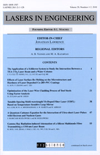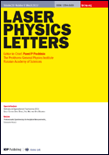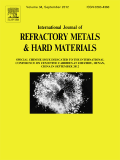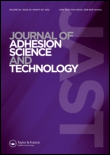
LASERS IN ENGINEERING
Scope & Guideline
Shaping the Future of Engineering with Cutting-Edge Laser Insights
Introduction
Aims and Scopes
- Laser Processing Techniques:
The journal covers a wide range of laser processing methods including welding, cladding, cutting, and surface modification, emphasizing their applications in various materials such as metals, polymers, and ceramics. - Material Characterization:
Research published in this journal frequently involves the characterization of materials processed with lasers, including studies on microstructure, mechanical properties, and performance under different conditions. - Innovative Applications:
The journal features innovative applications of laser technology across various fields including manufacturing, medical applications, and environmental monitoring, showcasing the versatility of laser techniques. - Optimization and Modeling:
A significant focus on optimizing laser processing parameters through simulations and experimental validations to enhance the efficiency and effectiveness of laser applications. - Interdisciplinary Research:
The journal encourages interdisciplinary studies that combine laser technology with fields such as materials science, mechanical engineering, and biomedical engineering.
Trending and Emerging
- Additive Manufacturing and 3D Printing:
An increasing number of publications focus on the use of laser technology in additive manufacturing, particularly in the context of selective laser melting and laser powder bed fusion techniques. - Laser Surface Treatment Techniques:
There is a growing interest in the development of advanced laser surface treatment methods, including laser shock peening and laser texturing, aimed at enhancing material properties and performance. - Smart Manufacturing and Industry 4.0:
Research addressing the integration of laser technologies within smart manufacturing frameworks and Industry 4.0 concepts is on the rise, reflecting a trend towards automation and intelligent production systems. - Biomedical Applications:
Emerging themes include the use of lasers in medical diagnostics and treatments, with a focus on innovative methods such as laser interferometry and laser-assisted surgeries. - Environmental Monitoring and Sensing:
Recent publications highlight the application of laser technologies in environmental monitoring, including remote sensing and detection of various environmental parameters, indicating a growing trend in sustainability-focused research.
Declining or Waning
- Traditional Welding Techniques:
While laser welding remains a core focus, there is a noticeable decline in papers exploring traditional welding techniques, as attention shifts towards advanced laser-based methods. - Basic Laser Physics:
Research focused solely on the fundamental physics of lasers has diminished, as the journal prioritizes applied research that demonstrates practical benefits and applications of laser technology. - Non-Engineering Applications:
Papers that explore non-engineering applications of lasers, such as purely artistic or aesthetic uses, have decreased, indicating a trend towards more engineering-centric topics.
Similar Journals

CHINESE JOURNAL OF LASERS-ZHONGGUO JIGUANG
Pioneering Insights in Optics and EngineeringCHINESE JOURNAL OF LASERS-ZHONGGUO JIGUANG is a premier academic publication dedicated to the fields of Atomic and Molecular Physics, Optics, and Electrical and Electronic Engineering. Established in 1991 and published by the esteemed CHINESE LASER PRESS, this journal serves as a crucial platform for researchers, professionals, and students to disseminate significant findings and innovations in laser technology and applications. With its consistent Q3 ranking in the respective categories, the journal is recognized for contributing valuable insights into electronic, optical, and magnetic materials, as well as advancing the understanding of laser phenomena. Although open access options are not available, the journal remains committed to fostering academic discourse and enhancing the visibility of groundbreaking research within and beyond China. The periodical is not only pivotal for those engaged in laser science but also for interdisciplinary studies that intersect with physics and engineering, making it an essential resource for contemporary scholars.

LASER PHYSICS LETTERS
Exploring Innovations in Laser TechnologyLASER PHYSICS LETTERS is a prestigious peer-reviewed journal published by IOP Publishing Ltd in the United Kingdom, focusing on the burgeoning field of laser physics and its applications. With an ISSN of 1612-2011 and an E-ISSN of 1612-202X, this journal stands at the intersection of innovative research and practical applications, addressing diverse topics within the realms of Instrumentation and Physics and Astronomy. Recognized for its impactful contributions, it boasts a ranking within the Q3 quartile for both relevant categories as of 2023, reflecting its steady rise and commitment to advancing knowledge in the area. Researchers and practitioners are encouraged to explore its content and contribute to the ongoing discourse that shapes the future of laser technologies. While LASER PHYSICS LETTERS does not currently offer open access options, its rigorous selection criteria ensure that published work is of the highest quality, positioning it as a vital resource for anyone engaged in laser science and engineering.

INTERNATIONAL JOURNAL OF REFRACTORY METALS & HARD MATERIALS
Leading the way in high-impact materials research.INTERNATIONAL JOURNAL OF REFRACTORY METALS & HARD MATERIALS, an esteemed publication by Elsevier Science Ltd, stands at the forefront of materials research, focusing on the development and application of refractory metals and hard materials in various engineering fields. With an impressive impact factor and recognition as a Q1 journal across several categories including Ceramics and Composites, Materials Chemistry, and Mechanical Engineering, it serves as a vital resource for researchers, professionals, and students alike. The journal has been continuously publishing high-quality research since its inception in 1982, with a convergence of developments spanning through to 2024. Its Scopus rankings further emphasize its significance, boasting ranks in the top percentiles of relevant scientific fields. Although it operates under a subscription model, the depth and rigor of the research published within its pages ensures that it remains an invaluable tool for those pursuing innovation and exploration in materials science.

Journal of Metals Materials and Minerals
Fostering Insights in the World of Materials and MineralsJournal of Metals Materials and Minerals (ISSN: 0857-6149) is a renowned academic publication dedicated to the interdisciplinary fields of metallurgical science, materials engineering, and mineralogy. Published by Chulalongkorn University, Metallurgy & Materials Science Research Institute in Thailand, this journal serves as a pivotal platform for researchers to disseminate their findings and explore innovative applications related to metals, ceramics, polymers, and biomaterials. Although the journal does not currently adopt an open-access model, it provides insightful content that facilitates knowledge sharing among professionals and academics alike. The journal has established its credibility with impressive Scopus ranking percentiles, particularly in categories such as Metals and Alloys and Ceramics and Composites. With an emphasis on advancing the understanding of materials science from 2017 to 2024, the Journal of Metals Materials and Minerals remains an essential resource for those striving to contribute to and stay informed about the latest trends and breakthroughs in these dynamic fields.

JOURNAL OF ADHESION SCIENCE AND TECHNOLOGY
Fostering Innovation in Adhesive Technologies and Practices.Journal of Adhesion Science and Technology is a distinguished publication within the fields of Chemistry, Materials Science, and Engineering, published by the reputable Taylor & Francis Ltd. Since its inception in 1987, the journal has been pivotal in advancing the understanding of adhesion mechanisms, technologies, and applications, boasting a conversion period extending to 2024. With a commendable impact factor and rankings placed in the Q2 category across various relevant domains, including Mechanics of Materials and Materials Chemistry, it offers a robust platform for scholars and practitioners alike. While currently not an open-access journal, it provides multiple access options, ensuring that vital research in adhesion science remains accessible to those dedicated to innovation and practical improvements in material interactions. This journal not only promotes empirical research but also encourages interdisciplinary collaboration, making it essential reading for researchers, industry professionals, and students eager to contribute to this dynamic field.

China Surface Engineering
Elevating materials science through collaborative insights.China Surface Engineering is a prominent academic journal dedicated to the field of materials science, with a specific emphasis on surfaces, coatings, and films. Published by the Chinese Association of Science and Technology (CAST), this journal serves as an essential platform for researchers, professionals, and students seeking to disseminate knowledge and advancements in surface engineering technologies and innovative applications. With its ISSN 1007-9289 and E-ISSN 1007-9289, it has established a distinct presence since its convergence in 2016, and continues to evolve in the rapidly advancing materials science landscape through to 2024. Although currently categorized in the Q4 quartile of its field, with a Scopus ranking of #103 out of 132 in Surfaces, Coatings and Films, the journal plays a critical role in contributing to the discourse surrounding surface treatment and modification, fostering advancements that are pivotal for industrial applications. As an avenue not only for knowledge transfer but also for collaboration among scientists worldwide, China Surface Engineering is crucial for anyone engaged in research or practical applications in this domain.

JOURNAL OF RUSSIAN LASER RESEARCH
Advancing Knowledge in Atomic and Molecular PhysicsThe Journal of Russian Laser Research, published by Springer, stands as a vital resource for researchers and professionals in the fields of atomic and molecular physics, as well as optics and engineering. With its ISSN 1071-2836 and E-ISSN 1573-8760, this journal has been disseminating groundbreaking research since its inception in 1994, with a dedicated focus on the advancement of laser technologies and their applications. While it currently holds a Q4 classification in both Atomic and Molecular Physics and Engineering categories, its commitment to fostering novel insights and innovative methodologies positions it as a promising platform for emerging studies within these disciplines. Although the journal does not offer open access options, it continues to draw attention with a growing citation index. By publishing diverse research articles, reviews, and critical discussions, the Journal of Russian Laser Research not only enriches academic literature but also serves as a stepping stone for students and professionals seeking to deepen their understanding of laser science and its myriad applications.

LASER PHYSICS
Shaping Tomorrow’s Laser Applications TodayLASER PHYSICS is a premier academic journal published by IOP Publishing Ltd, dedicated to the exploration and advancement of fundamental and applied research in the fields of Atomic and Molecular Physics, Optics, Condensed Matter Physics, Industrial and Manufacturing Engineering, and Instrumentation. Since its inception in 1996, the journal has been a vital resource for researchers and professionals, contributing significantly to the collective understanding of laser technology and its applications. With a consistent Q3 ranking across several sub-disciplines in the 2023 categories, LASER PHYSICS is recognized for its rigorous peer-reviewed articles that push the boundaries of current knowledge. Although primarily subscription-based, the journal aims to disseminate high-quality research to enhance the scientific community's collaboration. As the journal continues to shape the future of laser science until 2024 and beyond, it stands as an essential platform for both emerging and established scholars seeking to publish innovative findings in this dynamic field.

LASERS IN MEDICAL SCIENCE
Leading the Charge in Clinical Laser AdvancementsLASERS IN MEDICAL SCIENCE is a prestigious journal published by Springer London Ltd, dedicated to advancing the field of medical laser applications. With an ISSN of 0268-8921 and an E-ISSN of 1435-604X, this journal serves as a vital platform for the dissemination of innovative research and clinical advancements in dermatology and surgery. Recognized within the 2023 Q2 category for both dermatology and surgery, it holds significant prominence, ranking amidst the top quartiles of the respective fields. The journal's Scopus rankings further emphasize its influence, with a percentile standing of 80th in medicine surgery and 75th in medicine dermatology. Although it does not offer open access, its content is essential for researchers, practitioners, and students seeking the latest insights and evidence-based practices in the science of lasers for medical applications, thus contributing to improved patient outcomes. Operating from its UK base at 236 Grays Inn Rd, 6th Floor, London WC1X 8HL, LASERS IN MEDICAL SCIENCE continues to push the frontiers of knowledge in laser medicine from its inception in 1986 through to 2024.

International Journal of Surface Science and Engineering
Elevating Surface Science to New HeightsThe International Journal of Surface Science and Engineering, published by INDERSCIENCE ENTERPRISES LTD, serves as a vital platform for researchers and professionals in the field of mechanical engineering, surfaces, coatings, and materials science. With an ISSN of 1749-785X and an E-ISSN of 1749-7868, this journal disseminates innovative research addressing the challenges and advancements in surface technologies and engineering practices. Its scope includes, but is not limited to, surface coatings, interface properties, and novel material applications. Since its inception in 2007, the journal has established a solid reputation, achieving a Q3 ranking in Mechanical Engineering and Surfaces, Coatings and Films, and a Q4 ranking in Surfaces and Interfaces as of 2023. These metrics underscore the journal's growing influence, despite being positioned within the Q3 and Q4 quartiles of its categories. The International Journal of Surface Science and Engineering provides a curated collection of high-quality articles that contribute significantly to the understanding of surface phenomena, fostering collaboration and advancements in the field. Researchers, professionals, and students alike will find this journal an indispensable resource for cutting-edge developments and in-depth analyses.